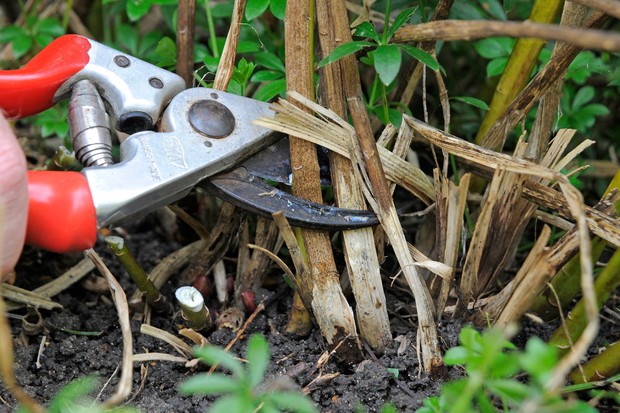
By autumn, many herbaceous perennials are running out of steam, with old foliage and flowers beginning to die back. It’s a good time to cut the old foliage back to the ground. The crown (base of the plant) will remain dormant over winter and will produce fresh shoots the following spring.
Dying stems can damage the crown and roots if battered about by autumn and winter gales, so they will benefit from being cut right back. In doing so, untidy clumps can be tidied up, too. Cutting back and clearing away foliage in autumn can also help to avoid fungal problems. Diseases can overwinter in dead and rotting foliage, which can also harbour slugs and other pests.
That’s not to say that all perennials should be cut back, though. Nowadays, many gardeners prefer to leave some perennials, especially those with attractive seedheads, intact – they give added interest in winter and provide vital food and shelter for wildlife. They can be cut back in spring, once they start to look messy, and when new growth is appearing at the base.
Discover our top tips on how to cut back herbaceous perennials, below.
Nowadays, many gardeners prefer to leave some perennials, especially those with attractive seedheads, intact.
Cut down old flower stems
Removing spent flower stems is the simplest type of pruning. As these are usually hollow, cut as low as possible and at an angle, so water doesn’t collect inside and freeze, damaging the crown. If new growth has already formed at the base of the clump, cut to just above it.
Cutting dead flower stems near their base with secateurs
Prune clump-forming perennials
Reduce clumps of perennials such as hardy geraniums, astrantias and alchemilla to ground level during autumn. Use secateurs to cut away all the dead foliage and tidy up the plant ready for winter. All perennials and grasses that die back can be tidied up in this way during autumn.

Cutting back alchemilla to ground level before winter
Leave attractive seedheads
Don’t cut back perennials with attractive seedheads or stems, such as ornamental grasses, thistles and umbellifers – they’ll add structure and interest over winter and will also provide vital food and shelter for wildlife. Discover plants with attractive seedheads.

Decorative echinacea seedheads
Perennials to leave
Some perennials, such as pulmonaria, retire back to a dense clump of basal foliage that should be left in place. Leave evergreen perennials, such as epimediums, euphorbias and hellebores. Don’t cut back penstemons until spring – the old stems will protect the crown from frost over winter.

Epimedium ‘Amber Queen’
Feeding your plants
After cutting back your plants in autumn, apply a light mulch around them. Then feed in spring for strong, healthy growth.

